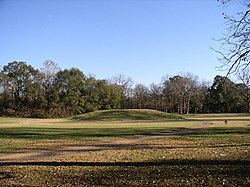Grand Village of the Natchez
|
Grand Village of the Natchez
|
|

Main mound at the Grand Village of the Natchez Site in Natchez, Mississippi
|
|
| Nearest city | 400 Jefferson Davis Boulevard, Natchez, Mississippi |
|---|---|
| Coordinates | 31°31′31″N 91°22′54″W / 31.525205°N 91.381638°WCoordinates: 31°31′31″N 91°22′54″W / 31.525205°N 91.381638°W |
| NRHP Reference # | 66000408 |
| Significant dates | |
| Added to NRHP | October 15, 1966 |
| Designated NHL | July 19, 1964 |
| Designated USMS | May 9, 1985 |
Grand Village of the Natchez, (22 AD 501) also known as the Fatherland Site, is a 128.1-acre (0.518 km2) site encompassing a prehistoric indigenous village and earthwork mounds in present-day south Natchez, Mississippi. The village complex was constructed starting about 1200 CE by members of the prehistoric Plaquemine culture. They built the three platform mounds in stages. Another phase of significant construction work by these prehistoric people has been dated to the mid-15th century. It was named for the historic Natchez people, who used the site in the 17th and 18th centuries.
In the early 18th century, when the historic Natchez people occupied the site, they added to the mounds.
The village was the Natchez tribe's main political and religious ceremonial center in the late 17th and early 18th centuries, according to historical and archaeological evidence. It replaced the Emerald Mound Site in this role. After suffering a 1730 military defeat by French settlers, the Natchez abandoned the site and moved away. In the early 19th century, the land was privately owned and cultivated as part of the Fatherland Plantation. Archaeological excavations started in 1930, and three mounds were found. (They had been partially buried by loess soils, with some erosion due to St. Catherine's Creek.)
The site was declared a National Historic Landmark in 1964 and a Mississippi Landmark in 1985.
Construction began at the site during the Anna phase of the prehistoric Plaquemine culture about 1200 CE. All of the varying soils used to build the mounds was carried by laborers by hand, probably in woven baskets. Skilled specialists knew how to use different soils to create the most stability. Later leaders directed additional work in the mid-15th century, in the Emerald phase of the Plaquemine culture. The site had three ceremonial platform mounds.
...
Wikipedia


